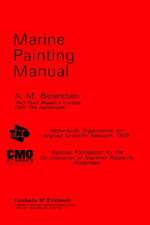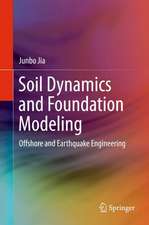Advances in Berthing and Mooring of Ships and Offshore Structures: NATO Science Series E:, cartea 146
Editat de E. Brattelanden Limba Engleză Paperback – 28 sep 2011
Din seria NATO Science Series E:
- 24%
 Preț: 1570.65 lei
Preț: 1570.65 lei -
 Preț: 397.76 lei
Preț: 397.76 lei -
 Preț: 386.81 lei
Preț: 386.81 lei - 20%
 Preț: 346.24 lei
Preț: 346.24 lei -
 Preț: 424.33 lei
Preț: 424.33 lei - 18%
 Preț: 1224.18 lei
Preț: 1224.18 lei - 18%
 Preț: 1836.63 lei
Preț: 1836.63 lei - 18%
 Preț: 1229.28 lei
Preț: 1229.28 lei -
 Preț: 381.00 lei
Preț: 381.00 lei -
 Preț: 409.30 lei
Preț: 409.30 lei - 18%
 Preț: 1841.36 lei
Preț: 1841.36 lei - 5%
 Preț: 367.28 lei
Preț: 367.28 lei -
 Preț: 407.19 lei
Preț: 407.19 lei - 18%
 Preț: 1838.38 lei
Preț: 1838.38 lei -
 Preț: 420.28 lei
Preț: 420.28 lei -
 Preț: 399.29 lei
Preț: 399.29 lei -
 Preț: 398.74 lei
Preț: 398.74 lei - 18%
 Preț: 3026.13 lei
Preț: 3026.13 lei -
 Preț: 388.90 lei
Preț: 388.90 lei - 5%
 Preț: 391.06 lei
Preț: 391.06 lei - 18%
 Preț: 1228.62 lei
Preț: 1228.62 lei - 18%
 Preț: 1229.73 lei
Preț: 1229.73 lei - 18%
 Preț: 1234.46 lei
Preț: 1234.46 lei - 5%
 Preț: 3532.05 lei
Preț: 3532.05 lei - 18%
 Preț: 1840.11 lei
Preț: 1840.11 lei - 5%
 Preț: 378.80 lei
Preț: 378.80 lei - 18%
 Preț: 1227.84 lei
Preț: 1227.84 lei -
 Preț: 392.75 lei
Preț: 392.75 lei -
 Preț: 395.63 lei
Preț: 395.63 lei - 18%
 Preț: 2489.30 lei
Preț: 2489.30 lei - 5%
 Preț: 1429.27 lei
Preț: 1429.27 lei -
 Preț: 396.02 lei
Preț: 396.02 lei - 5%
 Preț: 2142.61 lei
Preț: 2142.61 lei - 18%
 Preț: 3049.16 lei
Preț: 3049.16 lei - 18%
 Preț: 1844.54 lei
Preț: 1844.54 lei -
 Preț: 403.53 lei
Preț: 403.53 lei
Preț: 400.85 lei
Nou
Puncte Express: 601
Preț estimativ în valută:
76.70€ • 80.30$ • 63.47£
76.70€ • 80.30$ • 63.47£
Carte tipărită la comandă
Livrare economică 05-19 aprilie
Preluare comenzi: 021 569.72.76
Specificații
ISBN-13: 9789401071291
ISBN-10: 9401071292
Pagini: 516
Ilustrații: X, 501 p.
Dimensiuni: 155 x 235 x 27 mm
Greutate: 0.72 kg
Ediția:Softcover reprint of the original 1st ed. 1988
Editura: SPRINGER NETHERLANDS
Colecția Springer
Seria NATO Science Series E:
Locul publicării:Dordrecht, Netherlands
ISBN-10: 9401071292
Pagini: 516
Ilustrații: X, 501 p.
Dimensiuni: 155 x 235 x 27 mm
Greutate: 0.72 kg
Ediția:Softcover reprint of the original 1st ed. 1988
Editura: SPRINGER NETHERLANDS
Colecția Springer
Seria NATO Science Series E:
Locul publicării:Dordrecht, Netherlands
Public țintă
ResearchCuprins
Invited Lectures.- Historical Development of Berthing and Mooring.- Berthing and Mooring Accident Statistics and Use of Risk Analysis in Berthing and Mooring.- Marine Terminal Technology. Winch Berthing and Mooring. Recent Developments.- On the Prediction of Fender Forces at Berthing Structures. Part I: Calculation Method(s).- On the Prediction of Fender Forces at Berthing Structures. Part II: Ship Berthing Related to Fender Structure.- Use of Statistical Data and Methods in Impact Evaluation of Fender Design.- Wind and Wind Fluctuations.- Computer Modelling of Wave Propagation in Coastal Areas and Harbours.- Field Observations of Ship Behaviour at Berth.- Forces Related to Motions of Moored Ships. Analytical Methods of Moored Ship Motions.- Optimization and Safety Considerations in the Design of Stationkeeping Systems.- Simulation of Motions of Berthed Vessels - Simplified Simulation Model.- Written Contributions.- Rapid In Field Ferryberth Construction.- The Probabilistic Approach in the Selection of Ropes and Fenders.- Distribution of Berthing Speed and Eccentricity Factor of VLCC Investigated in Japan.- The Virtual Mass Coefficient of Berthing Ship.- Ships and Berth Structures Interactions.- Effect of Fluctuation of Wind on Ship Motions.- Consideration on Safety of Fendering System.- Long Waves and Moored Ship Behaviour at the Port of Sines - A Research Project.- Observation of Ship Motions in Rough Weather Conditions.- Effect of Characteristics of Mooring Systems and External Forces to Motions of Moored Ships.- Asymptotic and Variational Methods Applied to the Evaluation of Wave Drift Forces.- Mooring Systems of VLCC, LPGC and LNGC in Japan.- Effect of Mooring Lines on Ship Motions.- Ship Deck Machinery Design Forces, Arrangement and Equipment.- Mooring Systems forShips Harbouring in Port.- Fenders Installed in Japan.- Fenders Used in Turkey.- Experimental and Theoretical Investigation of an Advanced Fender/Mooring System Based on Energy Absorbing Principles.- To Whom is the Responsibility for Berthing and Mooring Operations to be Entrusted?.- Mooring Systems of the World Largest Floating Oil Storage Base.- The Use of Marine Fenders as Energy Absorbing Damper Units in Mooring Systems.- Possible Future Developments.- Conclusions and Recommendations.- List of Participants.
















